Financial Management Report: Long Term Finance and Appraisal
VerifiedAdded on 2023/01/13
|14
|3819
|99
Report
AI Summary
This report delves into financial management, focusing on long-term finance and equity finance. It analyzes a rights issue, determining the number of shares to be issued, theoretical ex-rights prices, and expected earnings per share under different scenarios. The report also calculates and evaluates investment appraisal techniques such as the payback period, accounting rate of return (ARR), net present value (NPV), and internal rate of return (IRR). Furthermore, it explores the concept of scrip dividends, outlining their advantages and disadvantages for both shareholders and the company. The analysis includes detailed calculations and recommendations based on the financial data provided, offering insights into investment decisions and financial planning strategies.

Financial Management
Paraphrase This Document
Need a fresh take? Get an instant paraphrase of this document with our AI Paraphraser
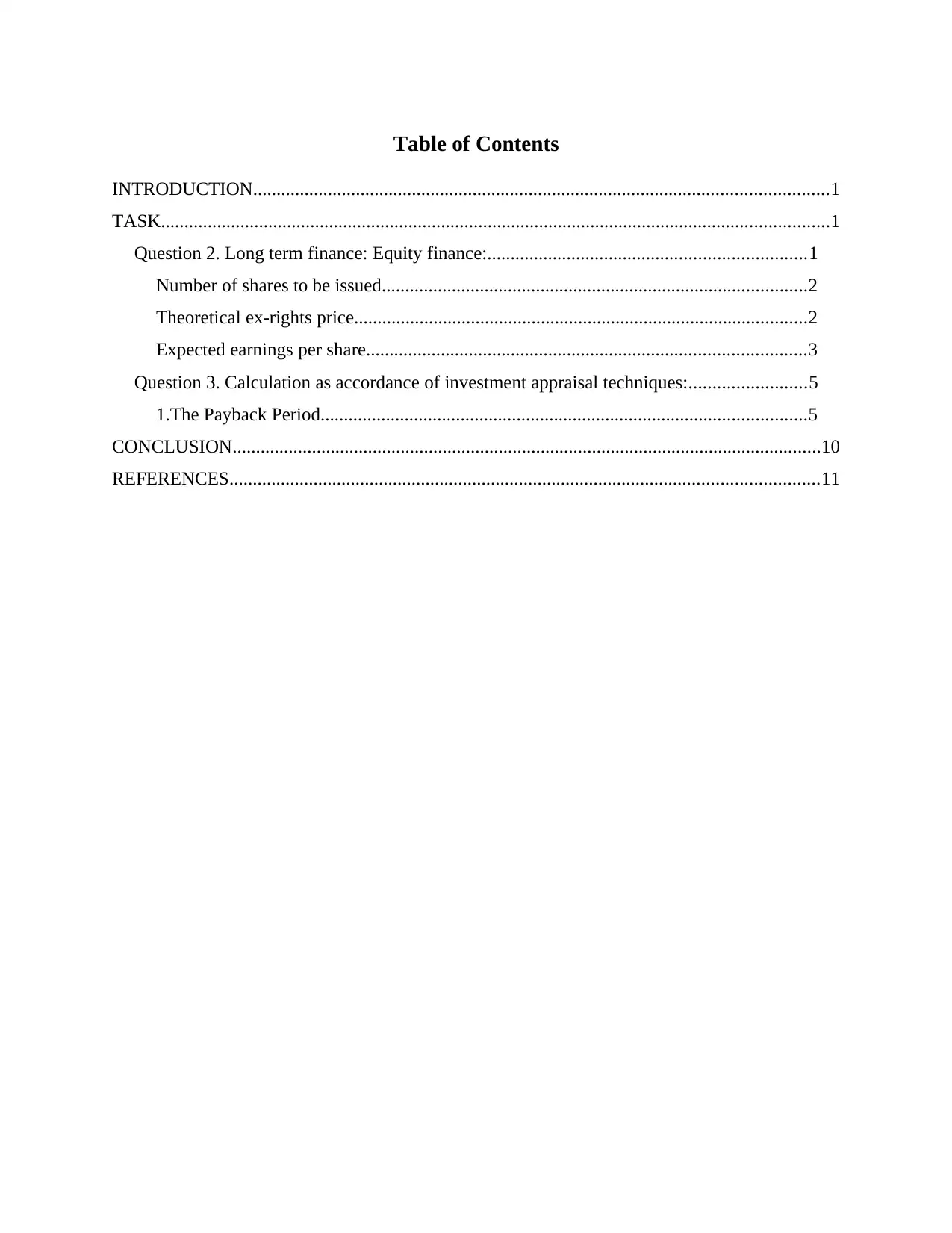
Table of Contents
INTRODUCTION...........................................................................................................................1
TASK...............................................................................................................................................1
Question 2. Long term finance: Equity finance:....................................................................1
Number of shares to be issued...........................................................................................2
Theoretical ex-rights price.................................................................................................2
Expected earnings per share..............................................................................................3
Question 3. Calculation as accordance of investment appraisal techniques:.........................5
1.The Payback Period........................................................................................................5
CONCLUSION..............................................................................................................................10
REFERENCES..............................................................................................................................11
INTRODUCTION...........................................................................................................................1
TASK...............................................................................................................................................1
Question 2. Long term finance: Equity finance:....................................................................1
Number of shares to be issued...........................................................................................2
Theoretical ex-rights price.................................................................................................2
Expected earnings per share..............................................................................................3
Question 3. Calculation as accordance of investment appraisal techniques:.........................5
1.The Payback Period........................................................................................................5
CONCLUSION..............................................................................................................................10
REFERENCES..............................................................................................................................11
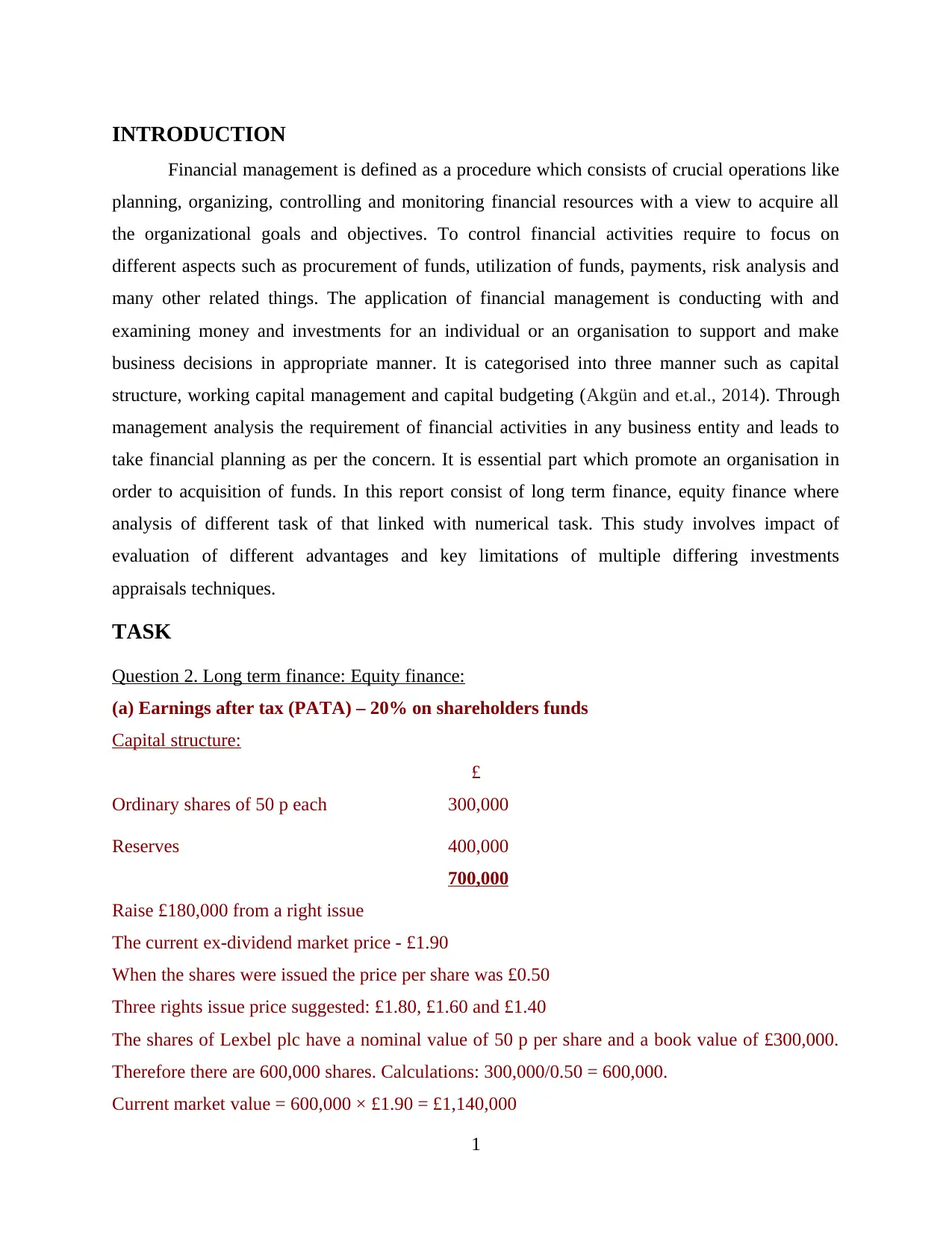
INTRODUCTION
Financial management is defined as a procedure which consists of crucial operations like
planning, organizing, controlling and monitoring financial resources with a view to acquire all
the organizational goals and objectives. To control financial activities require to focus on
different aspects such as procurement of funds, utilization of funds, payments, risk analysis and
many other related things. The application of financial management is conducting with and
examining money and investments for an individual or an organisation to support and make
business decisions in appropriate manner. It is categorised into three manner such as capital
structure, working capital management and capital budgeting (Akgün and et.al., 2014). Through
management analysis the requirement of financial activities in any business entity and leads to
take financial planning as per the concern. It is essential part which promote an organisation in
order to acquisition of funds. In this report consist of long term finance, equity finance where
analysis of different task of that linked with numerical task. This study involves impact of
evaluation of different advantages and key limitations of multiple differing investments
appraisals techniques.
TASK
Question 2. Long term finance: Equity finance:
(a) Earnings after tax (PATA) – 20% on shareholders funds
Capital structure:
£
Ordinary shares of 50 p each 300,000
Reserves 400,000
700,000
Raise £180,000 from a right issue
The current ex-dividend market price - £1.90
When the shares were issued the price per share was £0.50
Three rights issue price suggested: £1.80, £1.60 and £1.40
The shares of Lexbel plc have a nominal value of 50 p per share and a book value of £300,000.
Therefore there are 600,000 shares. Calculations: 300,000/0.50 = 600,000.
Current market value = 600,000 × £1.90 = £1,140,000
1
Financial management is defined as a procedure which consists of crucial operations like
planning, organizing, controlling and monitoring financial resources with a view to acquire all
the organizational goals and objectives. To control financial activities require to focus on
different aspects such as procurement of funds, utilization of funds, payments, risk analysis and
many other related things. The application of financial management is conducting with and
examining money and investments for an individual or an organisation to support and make
business decisions in appropriate manner. It is categorised into three manner such as capital
structure, working capital management and capital budgeting (Akgün and et.al., 2014). Through
management analysis the requirement of financial activities in any business entity and leads to
take financial planning as per the concern. It is essential part which promote an organisation in
order to acquisition of funds. In this report consist of long term finance, equity finance where
analysis of different task of that linked with numerical task. This study involves impact of
evaluation of different advantages and key limitations of multiple differing investments
appraisals techniques.
TASK
Question 2. Long term finance: Equity finance:
(a) Earnings after tax (PATA) – 20% on shareholders funds
Capital structure:
£
Ordinary shares of 50 p each 300,000
Reserves 400,000
700,000
Raise £180,000 from a right issue
The current ex-dividend market price - £1.90
When the shares were issued the price per share was £0.50
Three rights issue price suggested: £1.80, £1.60 and £1.40
The shares of Lexbel plc have a nominal value of 50 p per share and a book value of £300,000.
Therefore there are 600,000 shares. Calculations: 300,000/0.50 = 600,000.
Current market value = 600,000 × £1.90 = £1,140,000
1
⊘ This is a preview!⊘
Do you want full access?
Subscribe today to unlock all pages.

Trusted by 1+ million students worldwide

Market value after rights issue = current market value + funds to raise from rights issue =
£1,140,000 + £180,000 = £1,320,000
(b) Determining following tasks requirements:
Number of shares to be issued
Funds raised through right issue = £180,000
Number of new shares at £1.80 = £180,000 / £1.80 = 100,000
at £1.60 = £180,000 / £1.60 = 112,500
at £1.40 = £180,000 / £1.40 = 128,571
Theoretical ex-rights price
The formula used for the calculations (Watson & Head, 2019, p. 115):
Pe = Pp × + PN ×
Where: Pe = the theoretical ex-rights price
Pp = cum rights price
PN = rights issue price
NO = number of old shares
Nn = number of new shares
N = total number of shares after the issue
Total number of shares after the issue (number of old shares + number of new shares):
At rights issue price of £1.80 = 600,000 + 100,000 = 700,000
£1.60 = 600,000 + 112,500 = 712,500
£1.40 = 600,000 + 128,571 = 728,571
The theoretical ex-rights price:
At rights issue price of £1.80: Pe = 1.90 × + 1.80 × = £1.89
£1.60: Pe = 1.90 × + 1.60 × = £1.85
£1.40: Pe = 1.90 × + 1.40 × = £1.81
2
£1,140,000 + £180,000 = £1,320,000
(b) Determining following tasks requirements:
Number of shares to be issued
Funds raised through right issue = £180,000
Number of new shares at £1.80 = £180,000 / £1.80 = 100,000
at £1.60 = £180,000 / £1.60 = 112,500
at £1.40 = £180,000 / £1.40 = 128,571
Theoretical ex-rights price
The formula used for the calculations (Watson & Head, 2019, p. 115):
Pe = Pp × + PN ×
Where: Pe = the theoretical ex-rights price
Pp = cum rights price
PN = rights issue price
NO = number of old shares
Nn = number of new shares
N = total number of shares after the issue
Total number of shares after the issue (number of old shares + number of new shares):
At rights issue price of £1.80 = 600,000 + 100,000 = 700,000
£1.60 = 600,000 + 112,500 = 712,500
£1.40 = 600,000 + 128,571 = 728,571
The theoretical ex-rights price:
At rights issue price of £1.80: Pe = 1.90 × + 1.80 × = £1.89
£1.60: Pe = 1.90 × + 1.60 × = £1.85
£1.40: Pe = 1.90 × + 1.40 × = £1.81
2
Paraphrase This Document
Need a fresh take? Get an instant paraphrase of this document with our AI Paraphraser
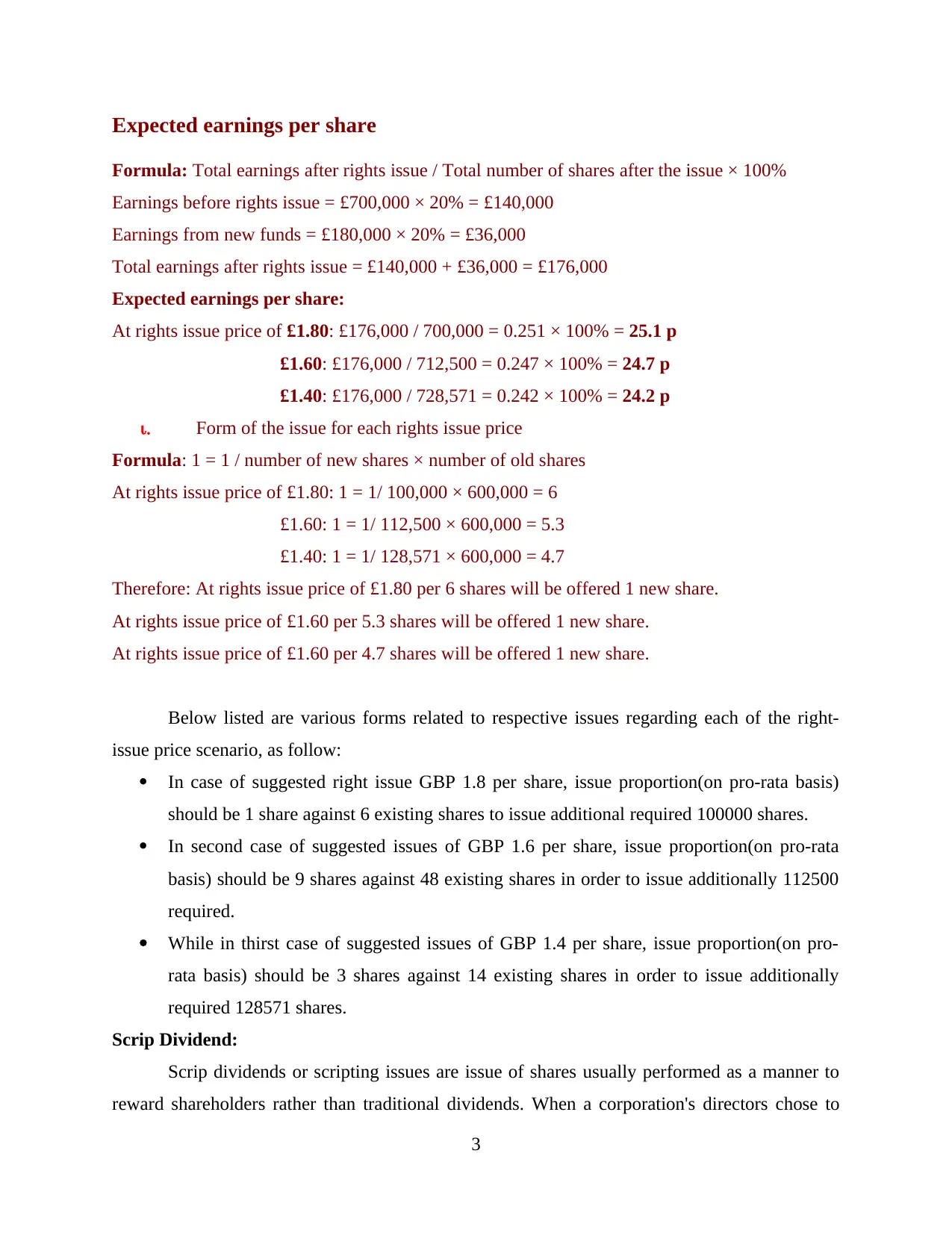
Expected earnings per share
Formula: Total earnings after rights issue / Total number of shares after the issue × 100%
Earnings before rights issue = £700,000 × 20% = £140,000
Earnings from new funds = £180,000 × 20% = £36,000
Total earnings after rights issue = £140,000 + £36,000 = £176,000
Expected earnings per share:
At rights issue price of £1.80: £176,000 / 700,000 = 0.251 × 100% = 25.1 p
£1.60: £176,000 / 712,500 = 0.247 × 100% = 24.7 p
£1.40: £176,000 / 728,571 = 0.242 × 100% = 24.2 p
i. Form of the issue for each rights issue price
Formula: 1 = 1 / number of new shares × number of old shares
At rights issue price of £1.80: 1 = 1/ 100,000 × 600,000 = 6
£1.60: 1 = 1/ 112,500 × 600,000 = 5.3
£1.40: 1 = 1/ 128,571 × 600,000 = 4.7
Therefore: At rights issue price of £1.80 per 6 shares will be offered 1 new share.
At rights issue price of £1.60 per 5.3 shares will be offered 1 new share.
At rights issue price of £1.60 per 4.7 shares will be offered 1 new share.
Below listed are various forms related to respective issues regarding each of the right-
issue price scenario, as follow:
In case of suggested right issue GBP 1.8 per share, issue proportion(on pro-rata basis)
should be 1 share against 6 existing shares to issue additional required 100000 shares.
In second case of suggested issues of GBP 1.6 per share, issue proportion(on pro-rata
basis) should be 9 shares against 48 existing shares in order to issue additionally 112500
required.
While in thirst case of suggested issues of GBP 1.4 per share, issue proportion(on pro-
rata basis) should be 3 shares against 14 existing shares in order to issue additionally
required 128571 shares.
Scrip Dividend:
Scrip dividends or scripting issues are issue of shares usually performed as a manner to
reward shareholders rather than traditional dividends. When a corporation's directors chose to
3
Formula: Total earnings after rights issue / Total number of shares after the issue × 100%
Earnings before rights issue = £700,000 × 20% = £140,000
Earnings from new funds = £180,000 × 20% = £36,000
Total earnings after rights issue = £140,000 + £36,000 = £176,000
Expected earnings per share:
At rights issue price of £1.80: £176,000 / 700,000 = 0.251 × 100% = 25.1 p
£1.60: £176,000 / 712,500 = 0.247 × 100% = 24.7 p
£1.40: £176,000 / 728,571 = 0.242 × 100% = 24.2 p
i. Form of the issue for each rights issue price
Formula: 1 = 1 / number of new shares × number of old shares
At rights issue price of £1.80: 1 = 1/ 100,000 × 600,000 = 6
£1.60: 1 = 1/ 112,500 × 600,000 = 5.3
£1.40: 1 = 1/ 128,571 × 600,000 = 4.7
Therefore: At rights issue price of £1.80 per 6 shares will be offered 1 new share.
At rights issue price of £1.60 per 5.3 shares will be offered 1 new share.
At rights issue price of £1.60 per 4.7 shares will be offered 1 new share.
Below listed are various forms related to respective issues regarding each of the right-
issue price scenario, as follow:
In case of suggested right issue GBP 1.8 per share, issue proportion(on pro-rata basis)
should be 1 share against 6 existing shares to issue additional required 100000 shares.
In second case of suggested issues of GBP 1.6 per share, issue proportion(on pro-rata
basis) should be 9 shares against 48 existing shares in order to issue additionally 112500
required.
While in thirst case of suggested issues of GBP 1.4 per share, issue proportion(on pro-
rata basis) should be 3 shares against 14 existing shares in order to issue additionally
required 128571 shares.
Scrip Dividend:
Scrip dividends or scripting issues are issue of shares usually performed as a manner to
reward shareholders rather than traditional dividends. When a corporation's directors chose to
3
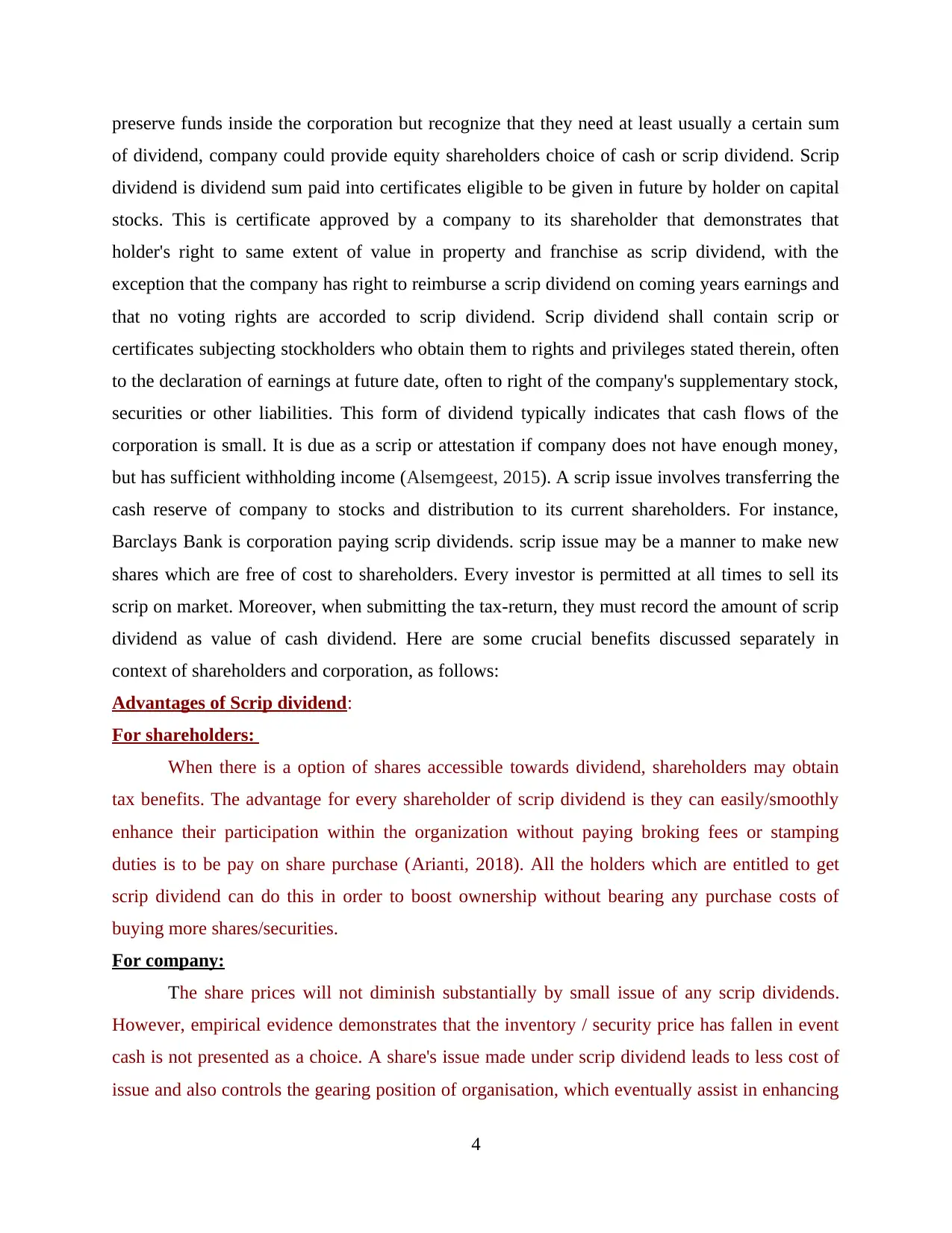
preserve funds inside the corporation but recognize that they need at least usually a certain sum
of dividend, company could provide equity shareholders choice of cash or scrip dividend. Scrip
dividend is dividend sum paid into certificates eligible to be given in future by holder on capital
stocks. This is certificate approved by a company to its shareholder that demonstrates that
holder's right to same extent of value in property and franchise as scrip dividend, with the
exception that the company has right to reimburse a scrip dividend on coming years earnings and
that no voting rights are accorded to scrip dividend. Scrip dividend shall contain scrip or
certificates subjecting stockholders who obtain them to rights and privileges stated therein, often
to the declaration of earnings at future date, often to right of the company's supplementary stock,
securities or other liabilities. This form of dividend typically indicates that cash flows of the
corporation is small. It is due as a scrip or attestation if company does not have enough money,
but has sufficient withholding income (Alsemgeest, 2015). A scrip issue involves transferring the
cash reserve of company to stocks and distribution to its current shareholders. For instance,
Barclays Bank is corporation paying scrip dividends. scrip issue may be a manner to make new
shares which are free of cost to shareholders. Every investor is permitted at all times to sell its
scrip on market. Moreover, when submitting the tax-return, they must record the amount of scrip
dividend as value of cash dividend. Here are some crucial benefits discussed separately in
context of shareholders and corporation, as follows:
Advantages of Scrip dividend:
For shareholders:
When there is a option of shares accessible towards dividend, shareholders may obtain
tax benefits. The advantage for every shareholder of scrip dividend is they can easily/smoothly
enhance their participation within the organization without paying broking fees or stamping
duties is to be pay on share purchase (Arianti, 2018). All the holders which are entitled to get
scrip dividend can do this in order to boost ownership without bearing any purchase costs of
buying more shares/securities.
For company:
The share prices will not diminish substantially by small issue of any scrip dividends.
However, empirical evidence demonstrates that the inventory / security price has fallen in event
cash is not presented as a choice. A share's issue made under scrip dividend leads to less cost of
issue and also controls the gearing position of organisation, which eventually assist in enhancing
4
of dividend, company could provide equity shareholders choice of cash or scrip dividend. Scrip
dividend is dividend sum paid into certificates eligible to be given in future by holder on capital
stocks. This is certificate approved by a company to its shareholder that demonstrates that
holder's right to same extent of value in property and franchise as scrip dividend, with the
exception that the company has right to reimburse a scrip dividend on coming years earnings and
that no voting rights are accorded to scrip dividend. Scrip dividend shall contain scrip or
certificates subjecting stockholders who obtain them to rights and privileges stated therein, often
to the declaration of earnings at future date, often to right of the company's supplementary stock,
securities or other liabilities. This form of dividend typically indicates that cash flows of the
corporation is small. It is due as a scrip or attestation if company does not have enough money,
but has sufficient withholding income (Alsemgeest, 2015). A scrip issue involves transferring the
cash reserve of company to stocks and distribution to its current shareholders. For instance,
Barclays Bank is corporation paying scrip dividends. scrip issue may be a manner to make new
shares which are free of cost to shareholders. Every investor is permitted at all times to sell its
scrip on market. Moreover, when submitting the tax-return, they must record the amount of scrip
dividend as value of cash dividend. Here are some crucial benefits discussed separately in
context of shareholders and corporation, as follows:
Advantages of Scrip dividend:
For shareholders:
When there is a option of shares accessible towards dividend, shareholders may obtain
tax benefits. The advantage for every shareholder of scrip dividend is they can easily/smoothly
enhance their participation within the organization without paying broking fees or stamping
duties is to be pay on share purchase (Arianti, 2018). All the holders which are entitled to get
scrip dividend can do this in order to boost ownership without bearing any purchase costs of
buying more shares/securities.
For company:
The share prices will not diminish substantially by small issue of any scrip dividends.
However, empirical evidence demonstrates that the inventory / security price has fallen in event
cash is not presented as a choice. A share's issue made under scrip dividend leads to less cost of
issue and also controls the gearing position of organisation, which eventually assist in enhancing
4
⊘ This is a preview!⊘
Do you want full access?
Subscribe today to unlock all pages.

Trusted by 1+ million students worldwide
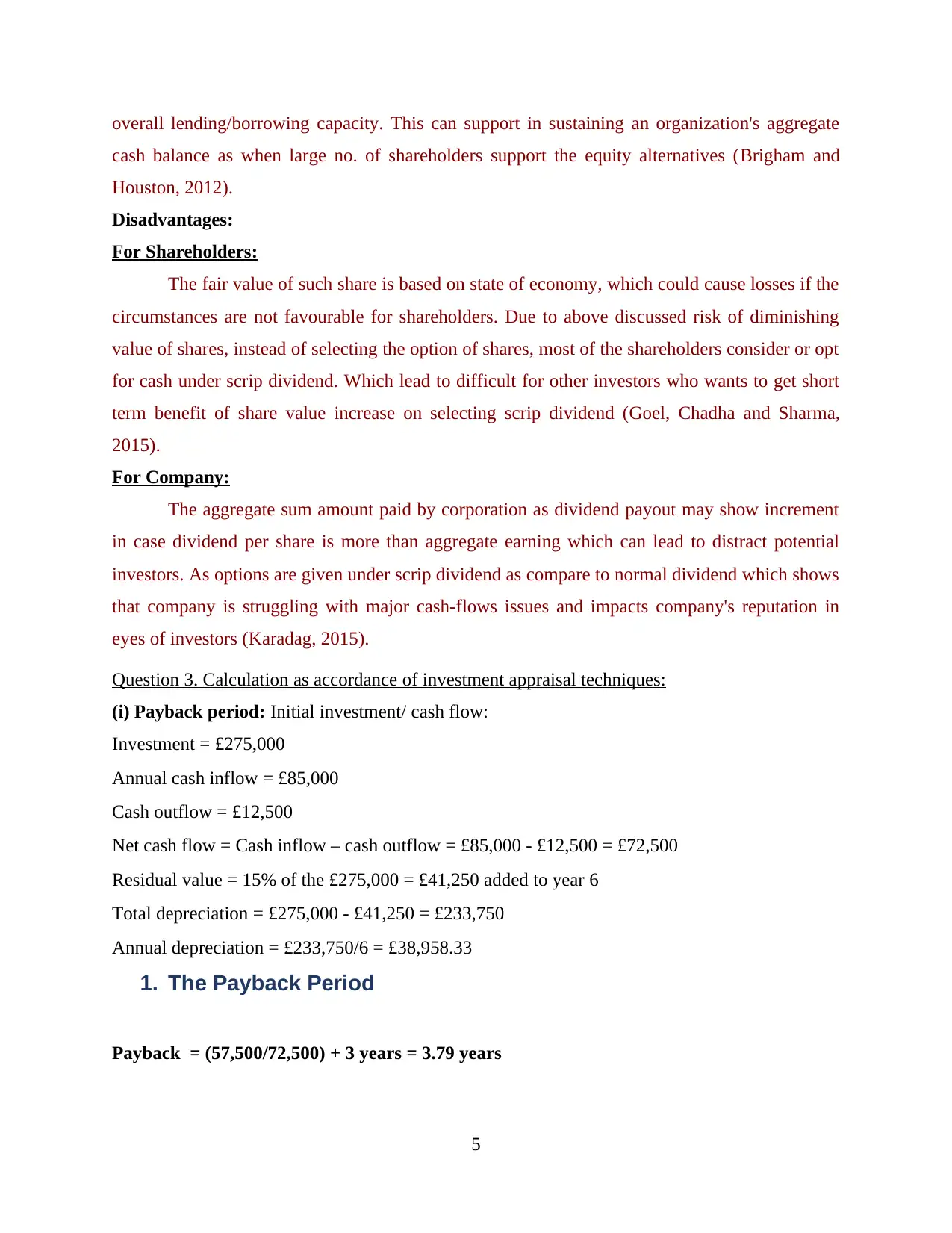
overall lending/borrowing capacity. This can support in sustaining an organization's aggregate
cash balance as when large no. of shareholders support the equity alternatives (Brigham and
Houston, 2012).
Disadvantages:
For Shareholders:
The fair value of such share is based on state of economy, which could cause losses if the
circumstances are not favourable for shareholders. Due to above discussed risk of diminishing
value of shares, instead of selecting the option of shares, most of the shareholders consider or opt
for cash under scrip dividend. Which lead to difficult for other investors who wants to get short
term benefit of share value increase on selecting scrip dividend (Goel, Chadha and Sharma,
2015).
For Company:
The aggregate sum amount paid by corporation as dividend payout may show increment
in case dividend per share is more than aggregate earning which can lead to distract potential
investors. As options are given under scrip dividend as compare to normal dividend which shows
that company is struggling with major cash-flows issues and impacts company's reputation in
eyes of investors (Karadag, 2015).
Question 3. Calculation as accordance of investment appraisal techniques:
(i) Payback period: Initial investment/ cash flow:
Investment = £275,000
Annual cash inflow = £85,000
Cash outflow = £12,500
Net cash flow = Cash inflow – cash outflow = £85,000 - £12,500 = £72,500
Residual value = 15% of the £275,000 = £41,250 added to year 6
Total depreciation = £275,000 - £41,250 = £233,750
Annual depreciation = £233,750/6 = £38,958.33
1. The Payback Period
Payback = (57,500/72,500) + 3 years = 3.79 years
5
cash balance as when large no. of shareholders support the equity alternatives (Brigham and
Houston, 2012).
Disadvantages:
For Shareholders:
The fair value of such share is based on state of economy, which could cause losses if the
circumstances are not favourable for shareholders. Due to above discussed risk of diminishing
value of shares, instead of selecting the option of shares, most of the shareholders consider or opt
for cash under scrip dividend. Which lead to difficult for other investors who wants to get short
term benefit of share value increase on selecting scrip dividend (Goel, Chadha and Sharma,
2015).
For Company:
The aggregate sum amount paid by corporation as dividend payout may show increment
in case dividend per share is more than aggregate earning which can lead to distract potential
investors. As options are given under scrip dividend as compare to normal dividend which shows
that company is struggling with major cash-flows issues and impacts company's reputation in
eyes of investors (Karadag, 2015).
Question 3. Calculation as accordance of investment appraisal techniques:
(i) Payback period: Initial investment/ cash flow:
Investment = £275,000
Annual cash inflow = £85,000
Cash outflow = £12,500
Net cash flow = Cash inflow – cash outflow = £85,000 - £12,500 = £72,500
Residual value = 15% of the £275,000 = £41,250 added to year 6
Total depreciation = £275,000 - £41,250 = £233,750
Annual depreciation = £233,750/6 = £38,958.33
1. The Payback Period
Payback = (57,500/72,500) + 3 years = 3.79 years
5
Paraphrase This Document
Need a fresh take? Get an instant paraphrase of this document with our AI Paraphraser

Year Cash Flows, £ Cumulative Cash Flows, £
0 -275,000 -275,000
1 72,500 -202,500
2 72,500 -130,000
3 72,500 -57,500
4 72,500 15,000
5 72,500 87,500
6 113,750 201,250
Recommendation – According to above figures, it is evident that respective project's
payback period is approx 3.79 years, which indicates that within 4 years, i.e. lower than the
length of project, the entity will recover costs incurred for purchasing machine.
(ii) Accounting rate of return: Average net profit / average investment *100
Annual Profit = Annual Net Cash flow – Annual Depreciation
Residual value £41,250 added to year 6
Year Annual Net
Cash Flows, £
Annual
Depreciation, £ Annual Profit, £
1 72,500 38,958.33 33,541.67
2 72,500 38,958.33 33,541.67
3 72,500 38,958.33 33,541.67
4 72,500 38,958.33 33,541.67
5 72,500 38,958.33 33,541.67
6 113,750 38,958.33 74,791.67
Step 2
Average Profit = Total profit / number of years
Total profit = £33,541.67 × 5 + £74,791.67 = £242,500.02
Average Profit = £242,500.02 / 6 = £40,416.70
Step 3
Average capital invested = (initial cost + residual value) / 2
Average capital invested = (275,000 + 41,250) /2 = £158,125
Step 4
The Accounting Rate of Return (ARR) = (average profit / average capital invested) ×100%
ARR = (40,416.70 / 158,125) × 100% = 25.56%
6
0 -275,000 -275,000
1 72,500 -202,500
2 72,500 -130,000
3 72,500 -57,500
4 72,500 15,000
5 72,500 87,500
6 113,750 201,250
Recommendation – According to above figures, it is evident that respective project's
payback period is approx 3.79 years, which indicates that within 4 years, i.e. lower than the
length of project, the entity will recover costs incurred for purchasing machine.
(ii) Accounting rate of return: Average net profit / average investment *100
Annual Profit = Annual Net Cash flow – Annual Depreciation
Residual value £41,250 added to year 6
Year Annual Net
Cash Flows, £
Annual
Depreciation, £ Annual Profit, £
1 72,500 38,958.33 33,541.67
2 72,500 38,958.33 33,541.67
3 72,500 38,958.33 33,541.67
4 72,500 38,958.33 33,541.67
5 72,500 38,958.33 33,541.67
6 113,750 38,958.33 74,791.67
Step 2
Average Profit = Total profit / number of years
Total profit = £33,541.67 × 5 + £74,791.67 = £242,500.02
Average Profit = £242,500.02 / 6 = £40,416.70
Step 3
Average capital invested = (initial cost + residual value) / 2
Average capital invested = (275,000 + 41,250) /2 = £158,125
Step 4
The Accounting Rate of Return (ARR) = (average profit / average capital invested) ×100%
ARR = (40,416.70 / 158,125) × 100% = 25.56%
6

Recommendation: As displayed in the aforementioned table of the valued rate of return,
this has been identified that ARR is about 12.19%. Thus in case organization Love-well limited
choose to buy such machinery then it will be beneficial for enterprise because it would produce
an annual return of about 12.19 per cent for six years.
(3) Net Present Value
Net Present Value (NPV) = £319,033.75 - £275,000 = £44,033.75
Recommendation- As per the above calculation, it has been suggested to the relevant
company that they choose to purchase machinery. The net present value of the equipment is also
£ 43700 which suggests a positive number. Therefore, as NPV is positive, the choice of buying
machines will be very beneficial for business.
(iv) Internal-rate of return:
IRR = R1 + R2-R1× NPV1NPV1-NPV2
IRR = 12% + R2-R1× 44,033.75 44,033.75 - NPV2
NPV2 = £254,881.25 - £275,000 = -£20,118.75
7
this has been identified that ARR is about 12.19%. Thus in case organization Love-well limited
choose to buy such machinery then it will be beneficial for enterprise because it would produce
an annual return of about 12.19 per cent for six years.
(3) Net Present Value
Net Present Value (NPV) = £319,033.75 - £275,000 = £44,033.75
Recommendation- As per the above calculation, it has been suggested to the relevant
company that they choose to purchase machinery. The net present value of the equipment is also
£ 43700 which suggests a positive number. Therefore, as NPV is positive, the choice of buying
machines will be very beneficial for business.
(iv) Internal-rate of return:
IRR = R1 + R2-R1× NPV1NPV1-NPV2
IRR = 12% + R2-R1× 44,033.75 44,033.75 - NPV2
NPV2 = £254,881.25 - £275,000 = -£20,118.75
7
⊘ This is a preview!⊘
Do you want full access?
Subscribe today to unlock all pages.

Trusted by 1+ million students worldwide
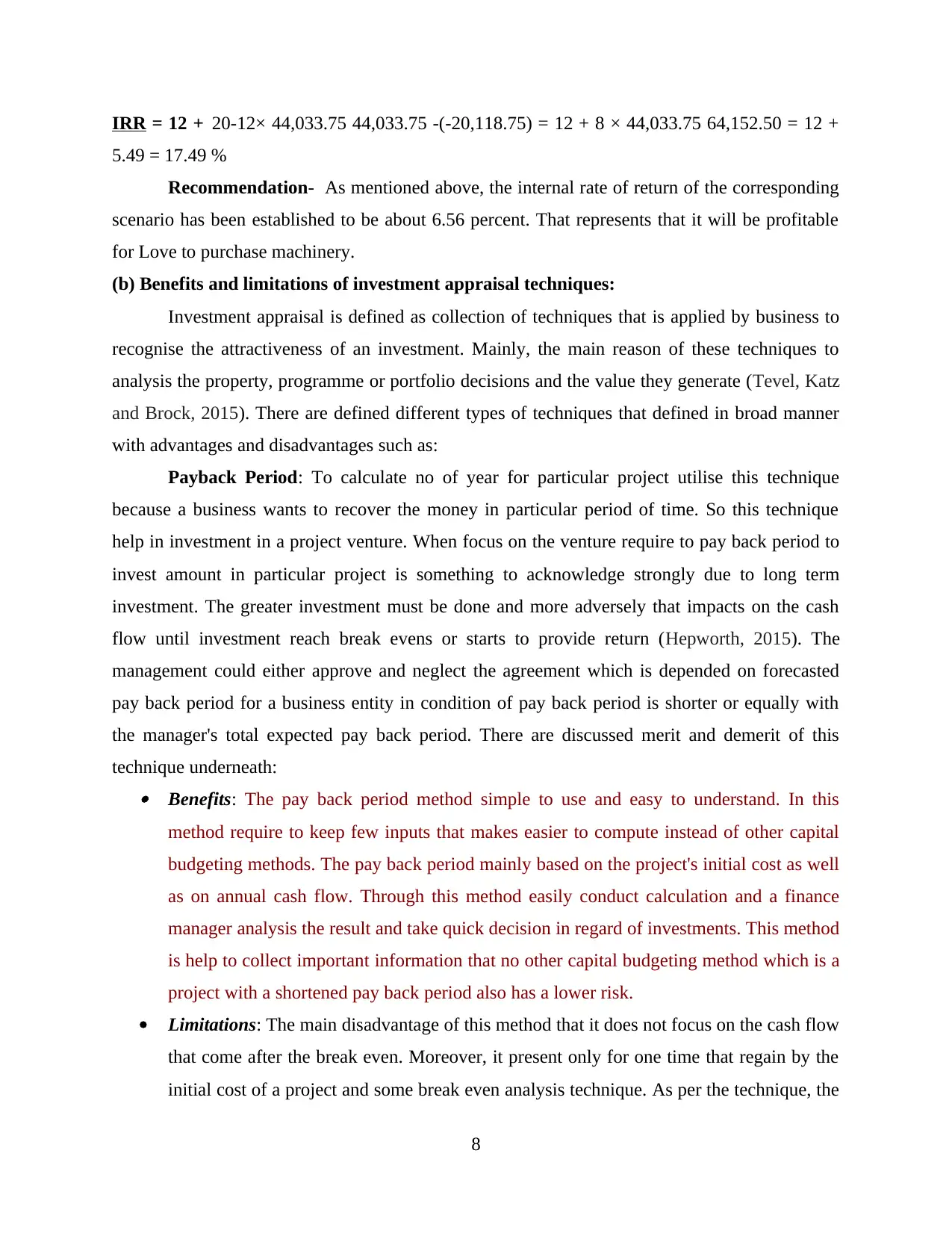
IRR = 12 + 20-12× 44,033.75 44,033.75 -(-20,118.75) = 12 + 8 × 44,033.75 64,152.50 = 12 +
5.49 = 17.49 %
Recommendation- As mentioned above, the internal rate of return of the corresponding
scenario has been established to be about 6.56 percent. That represents that it will be profitable
for Love to purchase machinery.
(b) Benefits and limitations of investment appraisal techniques:
Investment appraisal is defined as collection of techniques that is applied by business to
recognise the attractiveness of an investment. Mainly, the main reason of these techniques to
analysis the property, programme or portfolio decisions and the value they generate (Tevel, Katz
and Brock, 2015). There are defined different types of techniques that defined in broad manner
with advantages and disadvantages such as:
Payback Period: To calculate no of year for particular project utilise this technique
because a business wants to recover the money in particular period of time. So this technique
help in investment in a project venture. When focus on the venture require to pay back period to
invest amount in particular project is something to acknowledge strongly due to long term
investment. The greater investment must be done and more adversely that impacts on the cash
flow until investment reach break evens or starts to provide return (Hepworth, 2015). The
management could either approve and neglect the agreement which is depended on forecasted
pay back period for a business entity in condition of pay back period is shorter or equally with
the manager's total expected pay back period. There are discussed merit and demerit of this
technique underneath: Benefits: The pay back period method simple to use and easy to understand. In this
method require to keep few inputs that makes easier to compute instead of other capital
budgeting methods. The pay back period mainly based on the project's initial cost as well
as on annual cash flow. Through this method easily conduct calculation and a finance
manager analysis the result and take quick decision in regard of investments. This method
is help to collect important information that no other capital budgeting method which is a
project with a shortened pay back period also has a lower risk.
Limitations: The main disadvantage of this method that it does not focus on the cash flow
that come after the break even. Moreover, it present only for one time that regain by the
initial cost of a project and some break even analysis technique. As per the technique, the
8
5.49 = 17.49 %
Recommendation- As mentioned above, the internal rate of return of the corresponding
scenario has been established to be about 6.56 percent. That represents that it will be profitable
for Love to purchase machinery.
(b) Benefits and limitations of investment appraisal techniques:
Investment appraisal is defined as collection of techniques that is applied by business to
recognise the attractiveness of an investment. Mainly, the main reason of these techniques to
analysis the property, programme or portfolio decisions and the value they generate (Tevel, Katz
and Brock, 2015). There are defined different types of techniques that defined in broad manner
with advantages and disadvantages such as:
Payback Period: To calculate no of year for particular project utilise this technique
because a business wants to recover the money in particular period of time. So this technique
help in investment in a project venture. When focus on the venture require to pay back period to
invest amount in particular project is something to acknowledge strongly due to long term
investment. The greater investment must be done and more adversely that impacts on the cash
flow until investment reach break evens or starts to provide return (Hepworth, 2015). The
management could either approve and neglect the agreement which is depended on forecasted
pay back period for a business entity in condition of pay back period is shorter or equally with
the manager's total expected pay back period. There are discussed merit and demerit of this
technique underneath: Benefits: The pay back period method simple to use and easy to understand. In this
method require to keep few inputs that makes easier to compute instead of other capital
budgeting methods. The pay back period mainly based on the project's initial cost as well
as on annual cash flow. Through this method easily conduct calculation and a finance
manager analysis the result and take quick decision in regard of investments. This method
is help to collect important information that no other capital budgeting method which is a
project with a shortened pay back period also has a lower risk.
Limitations: The main disadvantage of this method that it does not focus on the cash flow
that come after the break even. Moreover, it present only for one time that regain by the
initial cost of a project and some break even analysis technique. As per the technique, the
8
Paraphrase This Document
Need a fresh take? Get an instant paraphrase of this document with our AI Paraphraser

particular method can create conflict with net present value that will be wrong. It is not
particular way for analysis that how shorter the pay back period should be invest into
project (Morden, 2016).
Accounting rate of return: It is one of the investment appraisal technique that known as
financial ratio and utilised in capital budgeting. This technique is not depended on the cash flows
that is applied in broad manner. It is a traditional method that use for measurement as well as
viability of project. This is a most popular technique which is assessed as a proportion of the
project that awaited average yearly net income to its total investment. The companies used this
method for feasibility measurement of a venture, mainly compare with other venture. Therefore,
the inability of ARR to make up for collected taxes, interest, inflation and cash flows that makes
it mistake fore longer time period planning (Osadchy and Akhmetshin, 2015). Advantages: Through this method get right point after then compute rather than cash
inflows. This method helps to compare particular project with other project and get
results for decision making. It is average investment method which is applied by the
online cheap accountants in east London to compute the return proportion on the amount
of average investment. This method easily applied by manager for analysis capital
projects that can be quickly by all. To calculate wise this method easy to apply and gain
result easily.
Disadvantages: This method more time on calculation due to selection in alternate.
Therefore, this is delusive method in order to compare two or more capital projects for
any business entity. ARR is mainly applied on basis of net profit that generate by capital
project and specially related with cash flow which is quite aspect for a business entity.
Net Present Value: It is defined as investment technique which is presenting a target
return of a given initial cost that has been achieved in certain period of time. NPV defines to
select initial investment expected to accomplish the target return when all else is the same. Net
present value is based on the discounted cash flow and initial investment proposal or venture
(Parker, 2012). Advantages: The main advantage of this method to consist of fact that focus on the time
value of money and supports to administration for effective decision making procedure. It
is not only supports in analysis of projects of same size but it also supports to recognising
a specific investment for generating profit.
9
particular way for analysis that how shorter the pay back period should be invest into
project (Morden, 2016).
Accounting rate of return: It is one of the investment appraisal technique that known as
financial ratio and utilised in capital budgeting. This technique is not depended on the cash flows
that is applied in broad manner. It is a traditional method that use for measurement as well as
viability of project. This is a most popular technique which is assessed as a proportion of the
project that awaited average yearly net income to its total investment. The companies used this
method for feasibility measurement of a venture, mainly compare with other venture. Therefore,
the inability of ARR to make up for collected taxes, interest, inflation and cash flows that makes
it mistake fore longer time period planning (Osadchy and Akhmetshin, 2015). Advantages: Through this method get right point after then compute rather than cash
inflows. This method helps to compare particular project with other project and get
results for decision making. It is average investment method which is applied by the
online cheap accountants in east London to compute the return proportion on the amount
of average investment. This method easily applied by manager for analysis capital
projects that can be quickly by all. To calculate wise this method easy to apply and gain
result easily.
Disadvantages: This method more time on calculation due to selection in alternate.
Therefore, this is delusive method in order to compare two or more capital projects for
any business entity. ARR is mainly applied on basis of net profit that generate by capital
project and specially related with cash flow which is quite aspect for a business entity.
Net Present Value: It is defined as investment technique which is presenting a target
return of a given initial cost that has been achieved in certain period of time. NPV defines to
select initial investment expected to accomplish the target return when all else is the same. Net
present value is based on the discounted cash flow and initial investment proposal or venture
(Parker, 2012). Advantages: The main advantage of this method to consist of fact that focus on the time
value of money and supports to administration for effective decision making procedure. It
is not only supports in analysis of projects of same size but it also supports to recognising
a specific investment for generating profit.
9
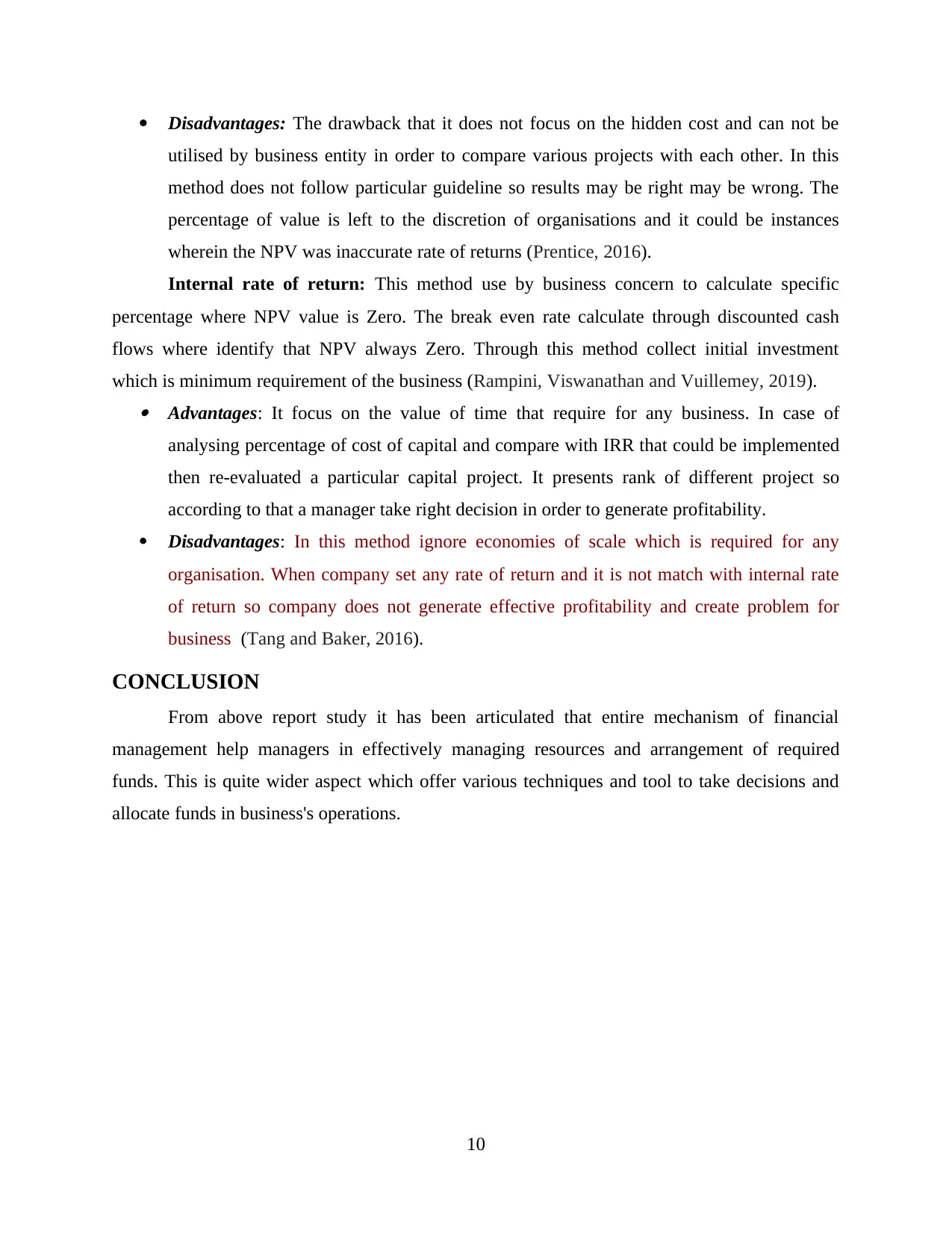
Disadvantages: The drawback that it does not focus on the hidden cost and can not be
utilised by business entity in order to compare various projects with each other. In this
method does not follow particular guideline so results may be right may be wrong. The
percentage of value is left to the discretion of organisations and it could be instances
wherein the NPV was inaccurate rate of returns (Prentice, 2016).
Internal rate of return: This method use by business concern to calculate specific
percentage where NPV value is Zero. The break even rate calculate through discounted cash
flows where identify that NPV always Zero. Through this method collect initial investment
which is minimum requirement of the business (Rampini, Viswanathan and Vuillemey, 2019). Advantages: It focus on the value of time that require for any business. In case of
analysing percentage of cost of capital and compare with IRR that could be implemented
then re-evaluated a particular capital project. It presents rank of different project so
according to that a manager take right decision in order to generate profitability.
Disadvantages: In this method ignore economies of scale which is required for any
organisation. When company set any rate of return and it is not match with internal rate
of return so company does not generate effective profitability and create problem for
business (Tang and Baker, 2016).
CONCLUSION
From above report study it has been articulated that entire mechanism of financial
management help managers in effectively managing resources and arrangement of required
funds. This is quite wider aspect which offer various techniques and tool to take decisions and
allocate funds in business's operations.
10
utilised by business entity in order to compare various projects with each other. In this
method does not follow particular guideline so results may be right may be wrong. The
percentage of value is left to the discretion of organisations and it could be instances
wherein the NPV was inaccurate rate of returns (Prentice, 2016).
Internal rate of return: This method use by business concern to calculate specific
percentage where NPV value is Zero. The break even rate calculate through discounted cash
flows where identify that NPV always Zero. Through this method collect initial investment
which is minimum requirement of the business (Rampini, Viswanathan and Vuillemey, 2019). Advantages: It focus on the value of time that require for any business. In case of
analysing percentage of cost of capital and compare with IRR that could be implemented
then re-evaluated a particular capital project. It presents rank of different project so
according to that a manager take right decision in order to generate profitability.
Disadvantages: In this method ignore economies of scale which is required for any
organisation. When company set any rate of return and it is not match with internal rate
of return so company does not generate effective profitability and create problem for
business (Tang and Baker, 2016).
CONCLUSION
From above report study it has been articulated that entire mechanism of financial
management help managers in effectively managing resources and arrangement of required
funds. This is quite wider aspect which offer various techniques and tool to take decisions and
allocate funds in business's operations.
10
⊘ This is a preview!⊘
Do you want full access?
Subscribe today to unlock all pages.

Trusted by 1+ million students worldwide
1 out of 14
Related Documents
Your All-in-One AI-Powered Toolkit for Academic Success.
+13062052269
info@desklib.com
Available 24*7 on WhatsApp / Email
![[object Object]](/_next/static/media/star-bottom.7253800d.svg)
Unlock your academic potential
Copyright © 2020–2025 A2Z Services. All Rights Reserved. Developed and managed by ZUCOL.




